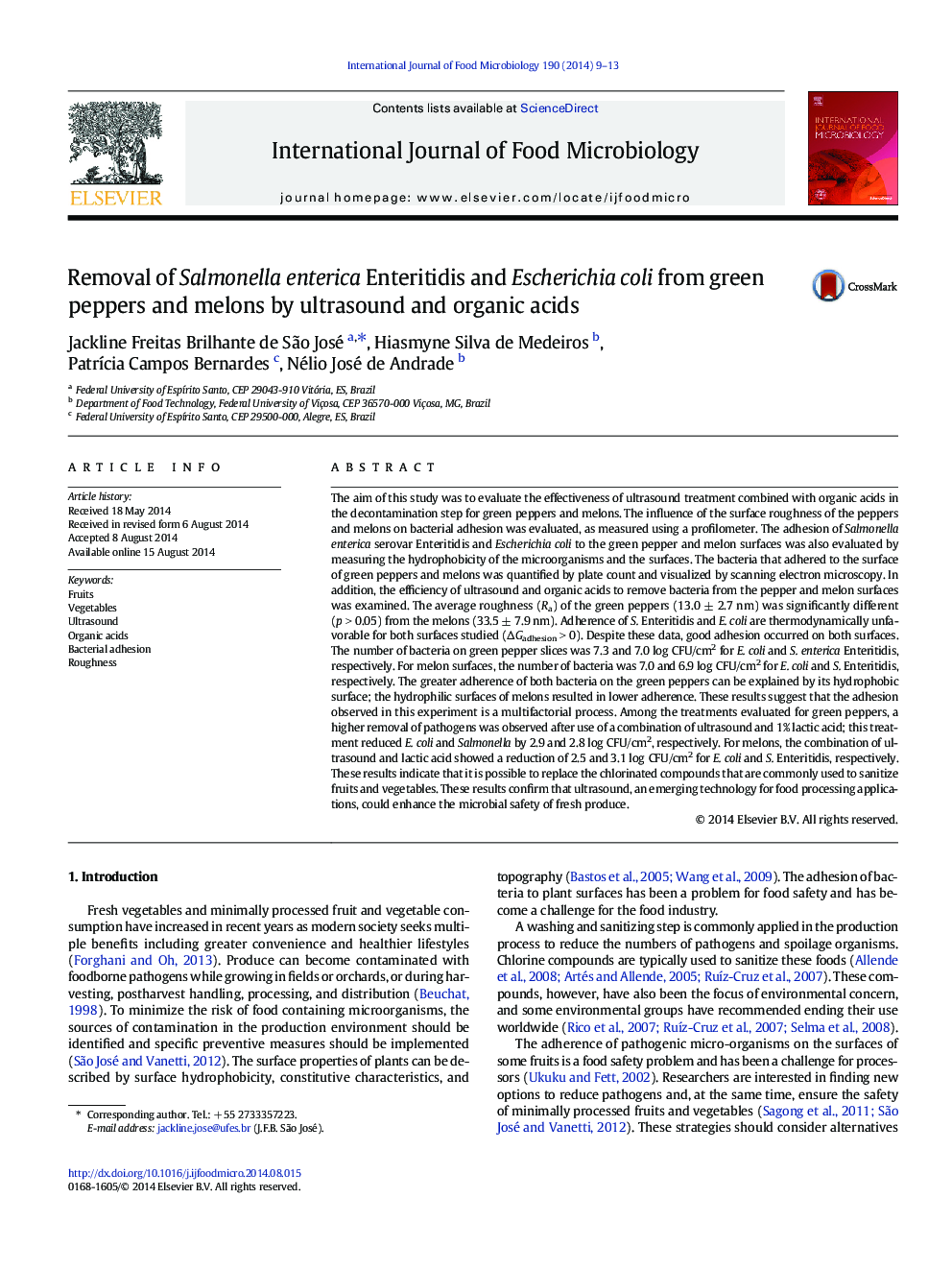| کد مقاله | کد نشریه | سال انتشار | مقاله انگلیسی | نسخه تمام متن |
|---|---|---|---|---|
| 4366802 | 1616593 | 2014 | 5 صفحه PDF | دانلود رایگان |
عنوان انگلیسی مقاله ISI
Removal of Salmonella enterica Enteritidis and Escherichia coli from green peppers and melons by ultrasound and organic acids
دانلود مقاله + سفارش ترجمه
دانلود مقاله ISI انگلیسی
رایگان برای ایرانیان
کلمات کلیدی
موضوعات مرتبط
علوم زیستی و بیوفناوری
علوم کشاورزی و بیولوژیک
دانش تغذیه
پیش نمایش صفحه اول مقاله

چکیده انگلیسی
The aim of this study was to evaluate the effectiveness of ultrasound treatment combined with organic acids in the decontamination step for green peppers and melons. The influence of the surface roughness of the peppers and melons on bacterial adhesion was evaluated, as measured using a profilometer. The adhesion of Salmonella enterica serovar Enteritidis and Escherichia coli to the green pepper and melon surfaces was also evaluated by measuring the hydrophobicity of the microorganisms and the surfaces. The bacteria that adhered to the surface of green peppers and melons was quantified by plate count and visualized by scanning electron microscopy. In addition, the efficiency of ultrasound and organic acids to remove bacteria from the pepper and melon surfaces was examined. The average roughness (Ra) of the green peppers (13.0 ± 2.7 nm) was significantly different (p > 0.05) from the melons (33.5 ± 7.9 nm). Adherence of S. Enteritidis and E. coli are thermodynamically unfavorable for both surfaces studied (âGadhesion > 0). Despite these data, good adhesion occurred on both surfaces. The number of bacteria on green pepper slices was 7.3 and 7.0 log CFU/cm2 for E. coli and S. enterica Enteritidis, respectively. For melon surfaces, the number of bacteria was 7.0 and 6.9 log CFU/cm2 for E. coli and S. Enteritidis, respectively. The greater adherence of both bacteria on the green peppers can be explained by its hydrophobic surface; the hydrophilic surfaces of melons resulted in lower adherence. These results suggest that the adhesion observed in this experiment is a multifactorial process. Among the treatments evaluated for green peppers, a higher removal of pathogens was observed after use of a combination of ultrasound and 1% lactic acid; this treatment reduced E. coli and Salmonella by 2.9 and 2.8 log CFU/cm2, respectively. For melons, the combination of ultrasound and lactic acid showed a reduction of 2.5 and 3.1 log CFU/cm2 for E. coli and S. Enteritidis, respectively. These results indicate that it is possible to replace the chlorinated compounds that are commonly used to sanitize fruits and vegetables. These results confirm that ultrasound, an emerging technology for food processing applications, could enhance the microbial safety of fresh produce.
ناشر
Database: Elsevier - ScienceDirect (ساینس دایرکت)
Journal: International Journal of Food Microbiology - Volume 190, 3 November 2014, Pages 9-13
Journal: International Journal of Food Microbiology - Volume 190, 3 November 2014, Pages 9-13
نویسندگان
Jackline Freitas Brilhante de São José, Hiasmyne Silva de Medeiros, PatrÃcia Campos Bernardes, Nélio José de Andrade,